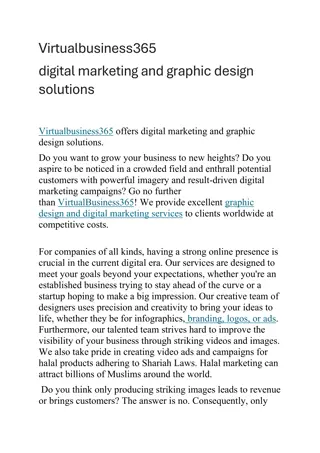Evolution of Marketing in Healthcare: A Historical Perspective
The evolution of marketing in healthcare has been significant, with the concept taking several decades to evolve. From the production era to the sales era and now the marketing era, hospitals have shifted their focus from quality products to attracting patients through various strategies. This presentation examines the different marketing eras in healthcare and how the industry has adapted over time.
Download Presentation

Please find below an Image/Link to download the presentation.
The content on the website is provided AS IS for your information and personal use only. It may not be sold, licensed, or shared on other websites without obtaining consent from the author. Download presentation by click this link. If you encounter any issues during the download, it is possible that the publisher has removed the file from their server.
E N D
Presentation Transcript
The Evolution of Marketing Dr. Karwan M. Amen Karwan.m.amen@gmail.com 2019 - 2020
Learning Outcomes By the end of this session, you will be able to ... Define the period of marketing evolution Describe the marketing culture
Introduction In both traditional businesses and in health care, the marketing concept has taken several decades to evolve. In health care, this evolution has occurred in a relatively short time period. As noted in the previous lecture, in 1975, the Evanston Hospital in Illinois was one of the first hospitals to hire a person with a marketing title.
Introduction cont., The marketing evolution eras include the following three periods: 1. Production era 2. Sales era 3. Marketing era
1. Production era At this stage of any businesses/companies evolution, the primary focus of the business was producing a high-quality product. In health care, many hospitals were and are at this stage in their own evolution. For a production-oriented hospital (focus on its production) or health care organisation, the focus is on providing high-quality medicine or delivering clinical quality.
2. Sales era At this stage, the focus for a hospital administrator was twofold. The first and top priority was to get as many patients as possible. Traditionally, this goal was accomplished by attracting as many physicians as possible to admit patients to the hospital.
2. Sales era cont., Hospitals developed many measures in order to fill the beds. Such as: - Sponsored seminars for physicians - Provided valet parking and attractive lounges.
2. Sales era cont., In the mid- 1970s, many hospitals adopted mass advertising strategies to promote their programs, including television and radio commercials advertising a particular service.
3. Marketing era The perspective of satisfying the wants and needs of consumers can and is being achieved. Health care providers can offer any number of services; the underlying question, however, becomes which service to offer? This is where a marketing- oriented perspective is valuable.
The evolution of marketing To recall: Orientation Hospital Production Clinical quality focus Sales Filling beds Marketing Identifying healthcare needs and meeting them
The marketing culture Some organisations achieve a final level of evolution, where marketing becomes part of the corporate culture, diffused throughout all levels of the organisation. The evolution to this stage may be seen in organisations that have adopted a patient-focused system.
The marketing culture cont., Rather than having the patient (costumer) go to the provider, the provider goes to patient whenever possible to administer the necessary clinical interventions. A marketing orientation has five distinct elements:
Marketing Orientation Elements 1. Costumer orientation: having a sufficient understanding of the target costumers in order to meets their needs. 2. Competitor orientation: recognising competitors strengths, weaknesses, and strategies.
Marketing orientation elements cont., 3. Interfunctional coordination: coordinating and deploying company resources in a manner that focuses on creating value for the costumer. Ex. Increase number of staff 4. long-term focus: continuous search for ways to add value by making appropriate business investments. 5. Profitability: earning profits sufficient to cover long-term expenses.























